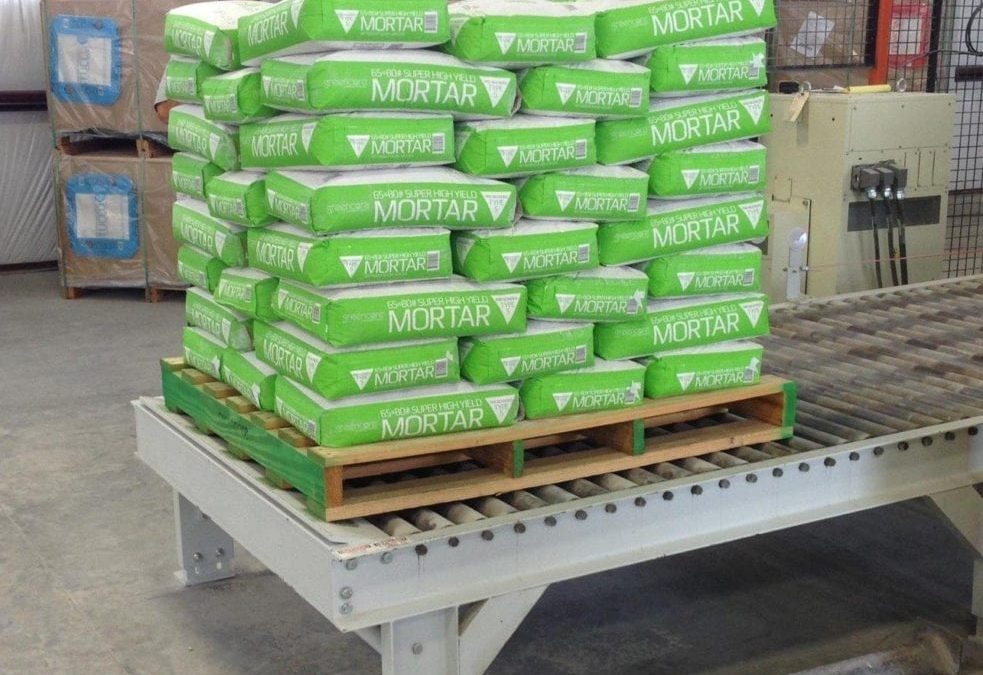A manufacturer of concrete and mortar mixes in central Florida was looking to replace a set of existing worn-out air packers to fill 80 lb. of pre-mixed concrete. The old machines had become increasingly unreliable and susceptible to unexpected downtime and maintenance. The machinery sustained excessive repetitive-motion wear and tear damage to several assemblies of the old machines.
For instance, they were continuously rebuilding the butterfly valve and its actuator which would typically only last four months before their product would wear it to the point of inoperability. Additionally, the spout and nozzle assemblies also experienced a high degree of wear as a result of the abrasive sand and gravel in their mixes. The filling spout would wear to the point of having a razor-sharp edge at the product discharge which was exactly where the operator manually placed empty bags onto the machine creating a constant safety hazard. The client wanted to continue using air packers but sought a solution that reduced the maintenance-related issues that they had experienced previously.
To achieve the client’s objectives, CBE designed a system with two (2) of its Model 730 Pressure Flow Air Packers with custom features designed especially for bagging abrasive products. The Model 730 had several distinct advantages for the application. First, each machine featured a plug stack inlet which allowed for pressurization of the product chamber of the machine without having to cycle the butterfly valve which all but eliminated the wear and tears it saw on the previous machines. Each machine still had a butterfly valve but it stayed locked open during normal operation and was only cycled on when the machines were emptied out at the end of a production run to change from one grade of product to another. Additionally, CBE designed heavy-duty filling spouts with hardened tips and heavy-walled blunt edges that would take much longer to wear (a year or better versus months with the previous spouts). Finally, the new Model 730’s featured 14” diameter hinged drop bottom access doors and a removable nozzle on handwheels that allowed for quick and easy cleanout and maintenance of the machines.
Bag filling was semi-automatic. Each filling sequence was sensor activated at the spout of the filling machine when the operator spouted a bag on the machine, no button push was required. Each bag would then fill to a pre-determined weight, selected by the operator, automatically. The filling machine had an integrated weighing scale, which worked in combination with a single PLC-based control package. The weighing controls were specially designed for valve bag filling applications and featured a gain-in-weight totalizing display. The controls were designed with the ability to communicate weight data to a printer or central management control system.
A pneumatic bag clamp sped up the placement and removal of the bags by eliminating the need for the operator to clamp and unclamp each bag from the filling spout at the beginning and end of each bag fill. The flow of material was automatically started and stopped by a multi-position pinch valve (called a pinch tube cutoff). The system controls actuate an integrated pinch valve that would completely stop the flow of product at the end of each weigh cycle to prevent overfilling.
The customer appreciated the simple digital controls of the machine which were as simple and easy to use. Although digital, their level of complexity was no more than the mechanical weighing scale units that the operators had been using. There was a 10 number digital keypad to adjust the target weight, a green button to start (in addition to the automatic start sensor at the spout), a red button to pause and stop bag fills, and a palm button emergency stop. No complicated menu screens to navigate or get lost in like some of the other machines that the customer had looked at for the product prior to selecting to partner with CBE on the project.
Each new machine was capable of filling 10-12 80 lb. bags per minute (20-24 BPM total).
After the successful implementation of the first system, our client followed up with a project to increase the production capability of the system to a rate of 24 bags per minute to match the potential of the robotic bag palletizing system. Although the existing 3-spout Model 730 could not be expanded, CBE developed a system plan that would pair a new 2-spout Model 730 alongside the existing 3-spout system and use a custom bag merge system of specially designed bag index conveyors. The indexing system allowed the 3-spout system to run at its full normal speed and the 2-spout system to fill in available gaps in the conveying system to maximize the flow of filled bags delivered to the palletizing system. This system expansion was again highly successful and allowed our client to increase production by an additional 25% above what the original system upgrade was capable of.


Recent Comments